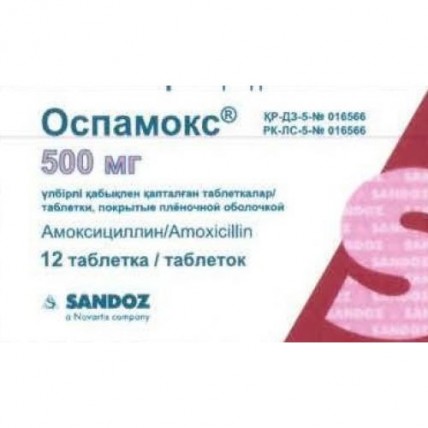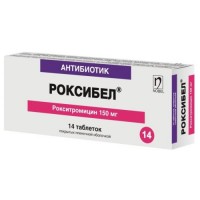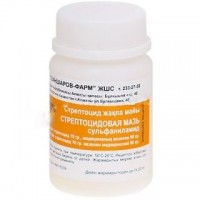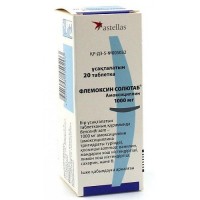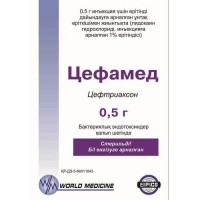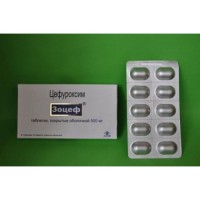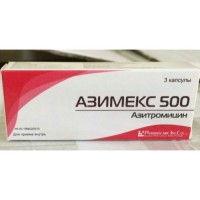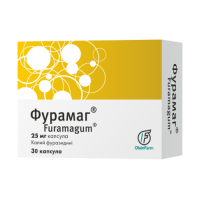Ospamoks 12s 500 mg coated tablets
- $12.70
The instruction for medical use
of Ospamoks® medicine
the Trade name
of Ospamoks®
the International unlicensed
name Amoxicillin Dosage Form
of the Tablet, film coated, 500 mg, 1000 mg
Structure
One tablet, film coated, contains
active agent - amoxicillin of trihydrate of 574.00 mg (equivalent 500.00 mg of amoxicillin) or 1148.00 mg (equivalent 1000.00 mg of amoxicillin)
excipients: magnesium stearate, PVP (To 25), sodium starch type A, cellulose microcrystalline glikolit, ethanol of 96% (in the form of 50% of solution)
structure of a film cover: the titan dioxide (E 171), the talc purified a hydroksipropilmetiltsellyuloza
the Description
of the Tablet, film coated, from white till cream color, oblong, with a biconvex surface, with risky on both parties, with a characteristic smell.
Pharmacotherapeutic group
Antibacterial drugs for system use. Beta laktamnye antibacterial drugs-penicillin. Penicillin of a broad spectrum of activity. Amoxicillin
the ATX J01CA04 Code
makes the Pharmacological Pharmacokinetics Absorption Absolute Bioavailability properties of amoxicillin from 75% to 90%. In the range of doses from 250 to 1000 mg (parameters: AUC and Cmax) bioavailability is linearly proportional to a dose. In higher doses the speed of absorption decreases. Meal does not influence amoxicillin absorption. At oral administration of one dose of 500 mg the concentration in plasma makes 6 - 11 mg/ml. After use of one dose of 3 g of amoxicillin the concentration in plasma makes 27 mg/ml. The maximum concentration in plasma are observed in 1-2 hours after introduction.
Distribution
Linking with proteins of blood plasma makes about 17%. Amoxicillin is well distributed in fabrics and liquids of an organism, including a phlegm, a purulent bronchial secret, bile and urine. In the absence of inflammation of a meninx, amoxicillin gets into cerebrospinal liquid in insignificant quantities. Amoxicillin passes through a placenta, the small percent is allocated in breast milk.
Biotransformation and removal
About 60-80% of an oral dose of amoxicillin is removed with urine in an invariable look within 6 hours after introduction. The insignificant quantity is removed with bile.
About 7-25% of the entered dose are metabolized in inactive penitsilloyny acid. Elimination half-life of amoxicillin at patients with normal function of kidneys makes about 1-1.5 h, patients with an end-stage of a renal failure have an elimination half-life of 5-20 h.
Children
At premature children with the term of a gestation of 26-33 weeks, the general clearance after intravenous administration of amoxicillin for 3 day of life, was in range from 0.75 to 2 ml/min. and was very similar to clearance of inulin (SKF) in this group of patients. After oral introduction the absorption and bioavailability of amoxicillin at small children can differ from those at adult patients. Therefore, in connection with reduction
of clearance, decrease in efficiency in this group of patients is expected though
such increase in influence can be partially reduced due to decrease in bioavailability at oral administration.
A pharmacodynamics
the action Mechanism
Amoxicillin - beta laktamny the antibiotic possessing a broad spectrum of activity. Amoxicillin represents the aminobenzylic penicillin possessing bactericidal action as a result of inhibition of synthesis of a bacterial cell wall.
For amoxicillin, time is higher than MPK (T>, MPK) is key pharmakodinamichesky parameter at assessment of clinical and bacteriological results.
The following microorganisms are sensitive to amoxicillin:
Gram-positive aerobes: Enterococcus of faecalis$, Listeria monocytogenes, Streptococcus agalactiae, Streptococcus bovis, Streptococcus pyogenes*.
Gram-negative aerobes: Helicobacter pylori.
Anaerobe bacterias: Peptostreptococci.
Others: Borrelia.
To amoxicillin the following microorganisms are insensitive:
Gram-positive aerobes: Enterococcus of faecium$, Streptococcus pneumoniae * +, Streptococcus viridans.
Gram-negative aerobes: Escherichia coli +, Haemophilus influenzae *,
Haemophilus para-influenzae *, Moraxella catarrhalis +, Proteus mirabilis
Anaerobe bacterias: Prevotella, Fusobacterium spp.
To rezistentna amoxicillin the following microorganisms:
Gram-positive aerobes: Staphylococcus aureus.
Gram-negative aerobes: Acinetobacter spp, Citrobacter spp, Enterobacter spp, Klebsiella spp, Legionella, Morganella morganii, Proteus vulgaris, Providencia spp, Pseudomonas spp, Serratia spp.
Anaerobe bacterias: Bacteroides fragilis.
Others: Chlamydia, Mycoplasma, Rickettsia.
* Clinical performance is shown concerning sensitivity of isolates within the approved clinical indications, distribution of pathogens & gt, 50%.
$ Natural intermediate types.
Bacteria can have resistance to amoxicillin as a result of products beta laktamaz, hydrolyzing aminopenitsllina, changes penicillin - the connecting proteins, disturbance of permeability for drug
or thanks to functioning of the special pompovy pumps extorting drug from a cell. At one microorganism there can
be at the same time several mechanisms of resistance that explains existence of variable and unpredictable resistance to others beta laktamnym and to antibacterial drugs from other groups.
Indications
Treatment of the infectious diseases caused by gram-positive and gram-negative microorganisms sensitive to amoxicillin:
- upper respiratory tract infection: including the acute average otitis, acute sinusitis and tonsillitis caused by a beta and hemolytic streptococcus of group A
- a lower respiratory tract infection: exacerbation of chronic bronchitis, community-acquired pneumonia, abscess of lungs, whooping cough (period of an incubation and initial stages)
- infections of urinary tract: cystitis
- prevention of an endocarditis
- treatment of the early localized stage of the disease of Lyme connected with the migrating erythema (1 stage)
- Helicobacter Pylori eradikation: in combination therapy with other antibacterial agent and antiulcerous means at adult patients with the peptic ulcer of a stomach associated with Helicobacter pylori
the Route of administration and doses
the Drug Ospamoks, tablets, film coated accept inside, whole, without chewing, washing down with liquid (for example, a glass of water). Meal does not influence amoxicillin absorption.
The dose of the drug Ospamoks depends on age, body weight and function of kidneys of the patient, weight and localization of an infection, sensitivity of a microorganism.
Adults and children of teenage age since 12 years (body weight more than 40 kg)
the Standard dose: from 750 mg to 3 g of the drug Ospamoks the day divided into 2 or 3 receptions.
Special recommendations concerning a dose
Tonsillitis: on 1000 mg of the drug Ospamoks 2 times a day.
Exacerbation of chronic bronchitis: on 1000 mg of the drug Ospamoks 2 times a
day.
Community-acquired pneumonia: on 1000 mg of the drug Ospamoks 3 times a day (each 8 hours).
The early localized stage of a disease of Lyme connected with the migrating erythema (1 stage): from 500 mg to 1000 mg of the drug Ospamoks 3 times a day, within 14-21 day.
Eradikation Helicobacter pylori: the drug Ospamoks is appointed on 1000 mg 2 times a day, in a combination from klaritromitsiny 500 mg 2 times a day and omeprazolum of 20 mg or lansoprazoly 30 mg by 2 times a day, within 7-14 days. At treatment of patients with resistance to a klaritromitsin more than 20% it is necessary to consider the alternative mode of therapy.
Children (body weight less than 40 kg)
children should appoint the Drug Ospamoks in the form of tablets from 12 years.
To children 12 years are younger and with body weight less than 40 kg it is necessary to appoint the drug Ospamoks in more convenient dosage form in the form of suspension for intake (for example, the drug Ospamoks, powder for preparation of suspension for intake of 125 mg / 5 ml or 250 mg / 5 ml).
The daily dose of the drug Ospamoks makes 40 - 90 mg/kg a day, divided into 2 or 3 receptions * (no more than 3000 mg a day) depending on indications, disease severity and sensitivity of a microorganism.
Pharmacokinetic / pharmakodinamicheskiye data show that at the dosing mode 3 times a day raise efficiency of therapy therefore the dosing mode 2 times a day is recommended only if the dose is in upper range.
Children with body weight more than 40 kg should appoint a standard adult dose of the drug Ospamoks.
Special recommendations concerning a dose
Tonsillitis: 50 mg/kg of the drug Ospamoks the day divided into 2 receptions.
The early localized stage of a disease of Lyme connected with the migrating erythema (1 stage): 50 mg/kg in day of the drug Ospamoks, divided into 3 receptions, within 14-21 day.
Prevention of an endocarditis: appoint 2000mg-3000mg the drug Ospamoks, accept inside in one hour prior to surgery.
Children: appoint 50 mg of amoxicillin/kg of body weight in the form of a single dose in one hour prior to surgery.
A renal failure
Patients with a heavy renal failure should reduce a dose.
To patients with renal clearance the interval between doses is recommended to increase lower than 30 ml/min. or to lower the subsequent doses.
The short course of treatment in the form of a single dose of 3000 mg is not applied in a renal failure.
Adult patients (including elderly patients)
Clearance of creatinine
of ml/min.
the Dose
the Interval between receptions
& gt, 30
Dose adjustment is not required.
10 -
30,500 mg
of 12 h
& lt,
10,500 mg
of 24 h
in case of a hemodialysis: administer the drug Ospamoks of 500 mg at the end of the procedure.
The renal failure with body weight less than 40 kg
Clearance of creatinine of ml/min.
the Dose
the Interval between uses
& gt, the 30th
standard dose
Dose adjustment is not required from children
10 - 30
standard dose
of 12 h (that there correspond 2/3 doses)
& lt, the 10th
standard dose
of 24 h (that there correspond 1/3 doses)
Dose adjustment is not required in an abnormal liver function.
Treatment duration.
Average course of treatment of 5-7 days. Treatment should be continued within 2 - 3 days after disappearance of symptoms. In case of the infections caused by a beta and hemolytic streptococcus duration of therapy makes 6-10 days for achievement of an eradikation of a microorganism.
Side effects
Classification of side effects: very often (≥1/10), it is frequent (from ≥1/100 to & lt, 1/10), infrequently (from ≥1/1.000 to & lt, 1/100), is rare (from ≥1/10.000 to & lt, 1/1.000), is very rare (& lt, 1/10.000), it is unknown (it is impossible to estimate on the basis of the available data).
often - a stomach ache, nausea, loss of appetite, vomiting, a meteorism, a soft chair, diarrhea, an enantema (especially in a mouth), dryness in a mouth, disturbances of taste. These side effects generally have easy temper and often disappear or during treatment, or soon after completion of therapy.
Emergence of these undesirable phenomena in general can be reduced, accepting amoxicillin at meal time.
- skin reactions, such as skin rash, an itching, urticaria, a typical korepodobny dieback happen in 5 - 11 days after the beginning of therapy. Immediate appearance of a small tortoiseshell specifies that there is an allergic reaction to amoxicillin and therapy it is necessary to stop.
infrequently
- superinfections and colonization with resistant microorganisms or barmy fungi, such as oral and vaginal candidiases, after long and repeated use of amoxicillin
- moderate and passing increase in level of liver enzymes
is rare
- an eosinophilic leukocytosis, hemolytic anemia
- a laryngeal edema, a serum disease, an allergic vasculitis, an anaphylaxis and an acute anaphylaxis
- a hyperkinesia, dizziness and spasms. Spasms can arise at patients with renal failures, epilepsies, meningitis or at the patients receiving high doses of amoxicillin
- discoloration of teeth (it is possible to remove by toothbrushing)
- hepatitis and cholestatic jaundice
- a Quincke's disease (Quincke's edema), a multiformny erythema, sharp generalized exanthematous pustulez, a Lyell's disease, Stephens-Johnson's syndrome, a toxic epidermal necrolysis violent or exfoliative dermatitis
- acute interstitial nephrite, a crystalluria
- fever
very seldom
- a lekopeniya, a neutropenia, a granulocytopenia, thrombocytopenia, a pancytopenia, anemia, myelosuppression, an agranulocytosis, increase in a bleeding time, increase in a prothrombin time. All symptoms were reversible and disappeared after the therapy termination
- when developing heavy and constant diarrhea very exceptional
cases of pseudomembranous colitis are possible, in this case use of antiperistaltic drugs is contraindicated. Coloring of language in black color is possible.
The contraindication
- hypersensitivity to penicillin, cross to others β - to laktamny antibiotics, such as cephalosporins
- hypersensitivity to any other excipients of drug
- pregnancy and the period of a lactation
Medicinal interactions
is not recommended by sensitivity sharing with the following
drugs Allopyrinolum.
Simultaneous administration of Allopyrinolum during treatment by amoxicillin can increase the probability of allergic skin reactions.
Digoxin
increase in absorption of digoxin at simultaneous use with amoxicillin is possible. Digoxin dose adjustment can be required.
Anticoagulants
Simultaneous use of amoxicillin and anticoagulants of a class of coumarins can extend a bleeding time. Dose adjustment of anticoagulants is necessary. Messages about increase in activity of oral anticoagulants at patients who received antibiotics arrived. As risk factors it is necessary to consider presence of infections and inflammations, age and the general condition of the patient. It is under such circumstances difficult to define reaction of infectious diseases to treatment and also communication with disturbances of MNO values. Nevertheless, some classes of antibiotics have a greater influence, in particular ftorkhinolona, macroleads, tsiklina, co-trimoxazole and some cephalosporins.
The methotrexate
Simultaneous use of amoxicillin and a methotrexate can increase toxicity of the last. It is necessary to control carefully methotrexate levels in blood at the patients accepting amoxicillin together with a methotrexate. Amoxicillin reduces renal clearance of a methotrexate therefore it is necessary to check the level of its concentration in blood plasma.
It is recommended
temporarily be careful when sharing with the following drugs Oral hormonal contraceptives Amoxicillin can lower the level of estrogen and progesterone in plasma and can reduce efficiency of oral contraceptives. Therefore it is recommended to take an additional non-hormonal birth control.
The Artificial diuresis leads other forms of interactions to decrease in concentration of amoxicillin in blood plasma by increase in its removal.
It is recommended at a research on presence of glucose in urine at treatment by amoxicillin to apply enzymatic methods with glucose oxydas. When using chemical methods usually note false positive result.
Amoxicillin can reduce amount of estriol in urine at pregnant women.
At high concentrations of amoxicillin the glycemia level in blood plasma can decrease.
Amoxicillin can influence protein definition by a colorimetric method.
Special instructions
before therapy using amoxicillin, it is necessary to study carefully existence at the patient of reactions of hypersensitivity to penicillin and cephalosporins. It is necessary to consider a possibility of cross hypersensitivity (10%-15%) at combined use with cephalosporins.
At patients with reaction of hypersensitivity to a beta laktamnym to antibiotics in the anamnesis were registered heavy, sometimes with the lethal result of reaction of hypersensitivity (anaphylactoid reactions).
At patients with a renal failure the removal of amoxicillin is delayed, depending on extent of disturbance, reduction of a daily dose can be required.
It is necessary to be careful when prescribing amoxicillin to premature children and during the neonatal period: careful monitoring of functions of kidneys, a liver and hematologic functions is necessary.
Prolonged use of amoxicillin can sometimes lead to the excess growth of some insensitive microorganisms or
fungi. Therefore it is necessary to watch carefully patients because of possibility of superinfection.
Emergence of an acute anaphylaxis or other heavy allergic reactions after oral administration of amoxicillin happens seldom.
Presence of high concentration of amoxicillin in urine can lead to sedimentation of decomposition products in uric catheters. Therefore in intervals the catheters should be checked visually. At use of high doses of amoxicillin it is recommended to support adequate intake of liquid and urination for minimization of a possibility of an amoksitsillinovy crystalluria.
It is not necessary to apply amoxicillin to treatment of bacterial infections at patients with viral infections, an acute lymphoblastoid leukosis and an infectious mononucleosis (in connection with the increased risk of erythematic rash on skin).
It must be kept in mind risk of developing pseudomembranous colitis in the presence at patients with heavy persistent diarrhea (in most cases, the caused Clostridium difficile). In this case it is necessary to stop intake of amoxicillin and to appoint causal treatment. Use of antiperistaltic drugs is contraindicated.
As well as when using others beta laktamnykh antibiotics, during therapy using high doses of amoxicillin it is necessary to carry out blood test regularly.
Spasms or epileptic seizures can be shown at the patients with a renal failure having epilepsy and inflammation of a meninx at reception of high doses of drug.
Emergence of a generalized erythema with fever and pustules in an initiation of treatment can demonstrate development of a sharp generalized eczematic pustulez, therefore, therapy by amoxicillin should be stopped.
At combined use of amoxicillin with a methotrexate it is necessary to control carefully methotrexate levels in blood.
Features of influence of medicine on ability to drive motor transport and to work with potentially dangerous mechanisms
are not revealed
Overdose
Symptoms: nausea, vomiting, dizziness, a headache, confusion of consciousness, a tremor, spasms, symptoms from
digestive tract and disorder of water and electrolytic balance. At patients with heavy renal failures, big overdoses can cause symptoms of renal toxicity, the crystalluria is possible.
Treatment: there is no specific antidote in case of overdose by amoxicillin.
It is necessary to cause vomiting or to wash out a stomach then to accept activated carbon and osmotic depletive. It is necessary to maintain water and electrolytic balance. Amoxicillin is removed from an organism by means of a hemodialysis (90% within 6 hours) or an artificial diuresis.
A form of release and packing
On 12 tablets (for a dosage of 500 mg) or 6 tablets (for a dosage of 1000 mg) in blister strip packaging from a film polyvinylchloride/polyvinylidene chloride and aluminum foil.
On 1 (for a dosage of 500 mg) or 2 (for a dosage of 1000 mg) blister strip packaging together with the instruction for use in the state and Russian languages place in a pack from cardboard.
To Store storage conditions at a temperature not higher than 25 wasps.
To store out of children's reach!
4 years
not to use a period of storage after the expiry date specified on packing.
Prescription status
According to the prescription
the Producer/packer/owner of the registration certificate
of Sandoz GmbH, Austria
Biochemiestrasse 10, A-6250 Kundl, Austria
the Address of the organization accepting in the territory of the Republic of Kazakhstan claims from consumers on quality of products (goods)
Representative office of JSC Sandoz Pharmasyyutikals d. d. in
Republic of Kazakhstan Republic of Kazakhstan, 050051, Almaty, Luganskogo St., 96, Business center "Keruyen", the 3rd floor.
Ph. +7 (727) 2581048 Fax: +7 (727) 2581047,
kzsdz.drugsafety@sandoz.com
8 800 080 0066 –
to Develop free number of dialing across Kazakhstan
of Ospamoks® medicine
the Trade name
of Ospamoks®
the International unlicensed
name Amoxicillin Dosage Form
of the Tablet, film coated, 500 mg, 1000 mg
Structure
One tablet, film coated, contains
active agent - amoxicillin of trihydrate of 574.00 mg (equivalent 500.00 mg of amoxicillin) or 1148.00 mg (equivalent 1000.00 mg of amoxicillin)
excipients: magnesium stearate, PVP (To 25), sodium starch type A, cellulose microcrystalline glikolit, ethanol of 96% (in the form of 50% of solution)
structure of a film cover: the titan dioxide (E 171), the talc purified a hydroksipropilmetiltsellyuloza
the Description
of the Tablet, film coated, from white till cream color, oblong, with a biconvex surface, with risky on both parties, with a characteristic smell.
Pharmacotherapeutic group
Antibacterial drugs for system use. Beta laktamnye antibacterial drugs-penicillin. Penicillin of a broad spectrum of activity. Amoxicillin
the ATX J01CA04 Code
makes the Pharmacological Pharmacokinetics Absorption Absolute Bioavailability properties of amoxicillin from 75% to 90%. In the range of doses from 250 to 1000 mg (parameters: AUC and Cmax) bioavailability is linearly proportional to a dose. In higher doses the speed of absorption decreases. Meal does not influence amoxicillin absorption. At oral administration of one dose of 500 mg the concentration in plasma makes 6 - 11 mg/ml. After use of one dose of 3 g of amoxicillin the concentration in plasma makes 27 mg/ml. The maximum concentration in plasma are observed in 1-2 hours after introduction.
Distribution
Linking with proteins of blood plasma makes about 17%. Amoxicillin is well distributed in fabrics and liquids of an organism, including a phlegm, a purulent bronchial secret, bile and urine. In the absence of inflammation of a meninx, amoxicillin gets into cerebrospinal liquid in insignificant quantities. Amoxicillin passes through a placenta, the small percent is allocated in breast milk.
Biotransformation and removal
About 60-80% of an oral dose of amoxicillin is removed with urine in an invariable look within 6 hours after introduction. The insignificant quantity is removed with bile.
About 7-25% of the entered dose are metabolized in inactive penitsilloyny acid. Elimination half-life of amoxicillin at patients with normal function of kidneys makes about 1-1.5 h, patients with an end-stage of a renal failure have an elimination half-life of 5-20 h.
Children
At premature children with the term of a gestation of 26-33 weeks, the general clearance after intravenous administration of amoxicillin for 3 day of life, was in range from 0.75 to 2 ml/min. and was very similar to clearance of inulin (SKF) in this group of patients. After oral introduction the absorption and bioavailability of amoxicillin at small children can differ from those at adult patients. Therefore, in connection with reduction
of clearance, decrease in efficiency in this group of patients is expected though
such increase in influence can be partially reduced due to decrease in bioavailability at oral administration.
A pharmacodynamics
the action Mechanism
Amoxicillin - beta laktamny the antibiotic possessing a broad spectrum of activity. Amoxicillin represents the aminobenzylic penicillin possessing bactericidal action as a result of inhibition of synthesis of a bacterial cell wall.
For amoxicillin, time is higher than MPK (T>, MPK) is key pharmakodinamichesky parameter at assessment of clinical and bacteriological results.
The following microorganisms are sensitive to amoxicillin:
Gram-positive aerobes: Enterococcus of faecalis$, Listeria monocytogenes, Streptococcus agalactiae, Streptococcus bovis, Streptococcus pyogenes*.
Gram-negative aerobes: Helicobacter pylori.
Anaerobe bacterias: Peptostreptococci.
Others: Borrelia.
To amoxicillin the following microorganisms are insensitive:
Gram-positive aerobes: Enterococcus of faecium$, Streptococcus pneumoniae * +, Streptococcus viridans.
Gram-negative aerobes: Escherichia coli +, Haemophilus influenzae *,
Haemophilus para-influenzae *, Moraxella catarrhalis +, Proteus mirabilis
Anaerobe bacterias: Prevotella, Fusobacterium spp.
To rezistentna amoxicillin the following microorganisms:
Gram-positive aerobes: Staphylococcus aureus.
Gram-negative aerobes: Acinetobacter spp, Citrobacter spp, Enterobacter spp, Klebsiella spp, Legionella, Morganella morganii, Proteus vulgaris, Providencia spp, Pseudomonas spp, Serratia spp.
Anaerobe bacterias: Bacteroides fragilis.
Others: Chlamydia, Mycoplasma, Rickettsia.
* Clinical performance is shown concerning sensitivity of isolates within the approved clinical indications, distribution of pathogens & gt, 50%.
$ Natural intermediate types.
Bacteria can have resistance to amoxicillin as a result of products beta laktamaz, hydrolyzing aminopenitsllina, changes penicillin - the connecting proteins, disturbance of permeability for drug
or thanks to functioning of the special pompovy pumps extorting drug from a cell. At one microorganism there can
be at the same time several mechanisms of resistance that explains existence of variable and unpredictable resistance to others beta laktamnym and to antibacterial drugs from other groups.
Indications
Treatment of the infectious diseases caused by gram-positive and gram-negative microorganisms sensitive to amoxicillin:
- upper respiratory tract infection: including the acute average otitis, acute sinusitis and tonsillitis caused by a beta and hemolytic streptococcus of group A
- a lower respiratory tract infection: exacerbation of chronic bronchitis, community-acquired pneumonia, abscess of lungs, whooping cough (period of an incubation and initial stages)
- infections of urinary tract: cystitis
- prevention of an endocarditis
- treatment of the early localized stage of the disease of Lyme connected with the migrating erythema (1 stage)
- Helicobacter Pylori eradikation: in combination therapy with other antibacterial agent and antiulcerous means at adult patients with the peptic ulcer of a stomach associated with Helicobacter pylori
the Route of administration and doses
the Drug Ospamoks, tablets, film coated accept inside, whole, without chewing, washing down with liquid (for example, a glass of water). Meal does not influence amoxicillin absorption.
The dose of the drug Ospamoks depends on age, body weight and function of kidneys of the patient, weight and localization of an infection, sensitivity of a microorganism.
Adults and children of teenage age since 12 years (body weight more than 40 kg)
the Standard dose: from 750 mg to 3 g of the drug Ospamoks the day divided into 2 or 3 receptions.
Special recommendations concerning a dose
Tonsillitis: on 1000 mg of the drug Ospamoks 2 times a day.
Exacerbation of chronic bronchitis: on 1000 mg of the drug Ospamoks 2 times a
day.
Community-acquired pneumonia: on 1000 mg of the drug Ospamoks 3 times a day (each 8 hours).
The early localized stage of a disease of Lyme connected with the migrating erythema (1 stage): from 500 mg to 1000 mg of the drug Ospamoks 3 times a day, within 14-21 day.
Eradikation Helicobacter pylori: the drug Ospamoks is appointed on 1000 mg 2 times a day, in a combination from klaritromitsiny 500 mg 2 times a day and omeprazolum of 20 mg or lansoprazoly 30 mg by 2 times a day, within 7-14 days. At treatment of patients with resistance to a klaritromitsin more than 20% it is necessary to consider the alternative mode of therapy.
Children (body weight less than 40 kg)
children should appoint the Drug Ospamoks in the form of tablets from 12 years.
To children 12 years are younger and with body weight less than 40 kg it is necessary to appoint the drug Ospamoks in more convenient dosage form in the form of suspension for intake (for example, the drug Ospamoks, powder for preparation of suspension for intake of 125 mg / 5 ml or 250 mg / 5 ml).
The daily dose of the drug Ospamoks makes 40 - 90 mg/kg a day, divided into 2 or 3 receptions * (no more than 3000 mg a day) depending on indications, disease severity and sensitivity of a microorganism.
Pharmacokinetic / pharmakodinamicheskiye data show that at the dosing mode 3 times a day raise efficiency of therapy therefore the dosing mode 2 times a day is recommended only if the dose is in upper range.
Children with body weight more than 40 kg should appoint a standard adult dose of the drug Ospamoks.
Special recommendations concerning a dose
Tonsillitis: 50 mg/kg of the drug Ospamoks the day divided into 2 receptions.
The early localized stage of a disease of Lyme connected with the migrating erythema (1 stage): 50 mg/kg in day of the drug Ospamoks, divided into 3 receptions, within 14-21 day.
Prevention of an endocarditis: appoint 2000mg-3000mg the drug Ospamoks, accept inside in one hour prior to surgery.
Children: appoint 50 mg of amoxicillin/kg of body weight in the form of a single dose in one hour prior to surgery.
A renal failure
Patients with a heavy renal failure should reduce a dose.
To patients with renal clearance the interval between doses is recommended to increase lower than 30 ml/min. or to lower the subsequent doses.
The short course of treatment in the form of a single dose of 3000 mg is not applied in a renal failure.
Adult patients (including elderly patients)
Clearance of creatinine
of ml/min.
the Dose
the Interval between receptions
& gt, 30
Dose adjustment is not required.
10 -
30,500 mg
of 12 h
& lt,
10,500 mg
of 24 h
in case of a hemodialysis: administer the drug Ospamoks of 500 mg at the end of the procedure.
The renal failure with body weight less than 40 kg
Clearance of creatinine of ml/min.
the Dose
the Interval between uses
& gt, the 30th
standard dose
Dose adjustment is not required from children
10 - 30
standard dose
of 12 h (that there correspond 2/3 doses)
& lt, the 10th
standard dose
of 24 h (that there correspond 1/3 doses)
Dose adjustment is not required in an abnormal liver function.
Treatment duration.
Average course of treatment of 5-7 days. Treatment should be continued within 2 - 3 days after disappearance of symptoms. In case of the infections caused by a beta and hemolytic streptococcus duration of therapy makes 6-10 days for achievement of an eradikation of a microorganism.
Side effects
Classification of side effects: very often (≥1/10), it is frequent (from ≥1/100 to & lt, 1/10), infrequently (from ≥1/1.000 to & lt, 1/100), is rare (from ≥1/10.000 to & lt, 1/1.000), is very rare (& lt, 1/10.000), it is unknown (it is impossible to estimate on the basis of the available data).
often - a stomach ache, nausea, loss of appetite, vomiting, a meteorism, a soft chair, diarrhea, an enantema (especially in a mouth), dryness in a mouth, disturbances of taste. These side effects generally have easy temper and often disappear or during treatment, or soon after completion of therapy.
Emergence of these undesirable phenomena in general can be reduced, accepting amoxicillin at meal time.
- skin reactions, such as skin rash, an itching, urticaria, a typical korepodobny dieback happen in 5 - 11 days after the beginning of therapy. Immediate appearance of a small tortoiseshell specifies that there is an allergic reaction to amoxicillin and therapy it is necessary to stop.
infrequently
- superinfections and colonization with resistant microorganisms or barmy fungi, such as oral and vaginal candidiases, after long and repeated use of amoxicillin
- moderate and passing increase in level of liver enzymes
is rare
- an eosinophilic leukocytosis, hemolytic anemia
- a laryngeal edema, a serum disease, an allergic vasculitis, an anaphylaxis and an acute anaphylaxis
- a hyperkinesia, dizziness and spasms. Spasms can arise at patients with renal failures, epilepsies, meningitis or at the patients receiving high doses of amoxicillin
- discoloration of teeth (it is possible to remove by toothbrushing)
- hepatitis and cholestatic jaundice
- a Quincke's disease (Quincke's edema), a multiformny erythema, sharp generalized exanthematous pustulez, a Lyell's disease, Stephens-Johnson's syndrome, a toxic epidermal necrolysis violent or exfoliative dermatitis
- acute interstitial nephrite, a crystalluria
- fever
very seldom
- a lekopeniya, a neutropenia, a granulocytopenia, thrombocytopenia, a pancytopenia, anemia, myelosuppression, an agranulocytosis, increase in a bleeding time, increase in a prothrombin time. All symptoms were reversible and disappeared after the therapy termination
- when developing heavy and constant diarrhea very exceptional
cases of pseudomembranous colitis are possible, in this case use of antiperistaltic drugs is contraindicated. Coloring of language in black color is possible.
The contraindication
- hypersensitivity to penicillin, cross to others β - to laktamny antibiotics, such as cephalosporins
- hypersensitivity to any other excipients of drug
- pregnancy and the period of a lactation
Medicinal interactions
is not recommended by sensitivity sharing with the following
drugs Allopyrinolum.
Simultaneous administration of Allopyrinolum during treatment by amoxicillin can increase the probability of allergic skin reactions.
Digoxin
increase in absorption of digoxin at simultaneous use with amoxicillin is possible. Digoxin dose adjustment can be required.
Anticoagulants
Simultaneous use of amoxicillin and anticoagulants of a class of coumarins can extend a bleeding time. Dose adjustment of anticoagulants is necessary. Messages about increase in activity of oral anticoagulants at patients who received antibiotics arrived. As risk factors it is necessary to consider presence of infections and inflammations, age and the general condition of the patient. It is under such circumstances difficult to define reaction of infectious diseases to treatment and also communication with disturbances of MNO values. Nevertheless, some classes of antibiotics have a greater influence, in particular ftorkhinolona, macroleads, tsiklina, co-trimoxazole and some cephalosporins.
The methotrexate
Simultaneous use of amoxicillin and a methotrexate can increase toxicity of the last. It is necessary to control carefully methotrexate levels in blood at the patients accepting amoxicillin together with a methotrexate. Amoxicillin reduces renal clearance of a methotrexate therefore it is necessary to check the level of its concentration in blood plasma.
It is recommended
temporarily be careful when sharing with the following drugs Oral hormonal contraceptives Amoxicillin can lower the level of estrogen and progesterone in plasma and can reduce efficiency of oral contraceptives. Therefore it is recommended to take an additional non-hormonal birth control.
The Artificial diuresis leads other forms of interactions to decrease in concentration of amoxicillin in blood plasma by increase in its removal.
It is recommended at a research on presence of glucose in urine at treatment by amoxicillin to apply enzymatic methods with glucose oxydas. When using chemical methods usually note false positive result.
Amoxicillin can reduce amount of estriol in urine at pregnant women.
At high concentrations of amoxicillin the glycemia level in blood plasma can decrease.
Amoxicillin can influence protein definition by a colorimetric method.
Special instructions
before therapy using amoxicillin, it is necessary to study carefully existence at the patient of reactions of hypersensitivity to penicillin and cephalosporins. It is necessary to consider a possibility of cross hypersensitivity (10%-15%) at combined use with cephalosporins.
At patients with reaction of hypersensitivity to a beta laktamnym to antibiotics in the anamnesis were registered heavy, sometimes with the lethal result of reaction of hypersensitivity (anaphylactoid reactions).
At patients with a renal failure the removal of amoxicillin is delayed, depending on extent of disturbance, reduction of a daily dose can be required.
It is necessary to be careful when prescribing amoxicillin to premature children and during the neonatal period: careful monitoring of functions of kidneys, a liver and hematologic functions is necessary.
Prolonged use of amoxicillin can sometimes lead to the excess growth of some insensitive microorganisms or
fungi. Therefore it is necessary to watch carefully patients because of possibility of superinfection.
Emergence of an acute anaphylaxis or other heavy allergic reactions after oral administration of amoxicillin happens seldom.
Presence of high concentration of amoxicillin in urine can lead to sedimentation of decomposition products in uric catheters. Therefore in intervals the catheters should be checked visually. At use of high doses of amoxicillin it is recommended to support adequate intake of liquid and urination for minimization of a possibility of an amoksitsillinovy crystalluria.
It is not necessary to apply amoxicillin to treatment of bacterial infections at patients with viral infections, an acute lymphoblastoid leukosis and an infectious mononucleosis (in connection with the increased risk of erythematic rash on skin).
It must be kept in mind risk of developing pseudomembranous colitis in the presence at patients with heavy persistent diarrhea (in most cases, the caused Clostridium difficile). In this case it is necessary to stop intake of amoxicillin and to appoint causal treatment. Use of antiperistaltic drugs is contraindicated.
As well as when using others beta laktamnykh antibiotics, during therapy using high doses of amoxicillin it is necessary to carry out blood test regularly.
Spasms or epileptic seizures can be shown at the patients with a renal failure having epilepsy and inflammation of a meninx at reception of high doses of drug.
Emergence of a generalized erythema with fever and pustules in an initiation of treatment can demonstrate development of a sharp generalized eczematic pustulez, therefore, therapy by amoxicillin should be stopped.
At combined use of amoxicillin with a methotrexate it is necessary to control carefully methotrexate levels in blood.
Features of influence of medicine on ability to drive motor transport and to work with potentially dangerous mechanisms
are not revealed
Overdose
Symptoms: nausea, vomiting, dizziness, a headache, confusion of consciousness, a tremor, spasms, symptoms from
digestive tract and disorder of water and electrolytic balance. At patients with heavy renal failures, big overdoses can cause symptoms of renal toxicity, the crystalluria is possible.
Treatment: there is no specific antidote in case of overdose by amoxicillin.
It is necessary to cause vomiting or to wash out a stomach then to accept activated carbon and osmotic depletive. It is necessary to maintain water and electrolytic balance. Amoxicillin is removed from an organism by means of a hemodialysis (90% within 6 hours) or an artificial diuresis.
A form of release and packing
On 12 tablets (for a dosage of 500 mg) or 6 tablets (for a dosage of 1000 mg) in blister strip packaging from a film polyvinylchloride/polyvinylidene chloride and aluminum foil.
On 1 (for a dosage of 500 mg) or 2 (for a dosage of 1000 mg) blister strip packaging together with the instruction for use in the state and Russian languages place in a pack from cardboard.
To Store storage conditions at a temperature not higher than 25 wasps.
To store out of children's reach!
4 years
not to use a period of storage after the expiry date specified on packing.
Prescription status
According to the prescription
the Producer/packer/owner of the registration certificate
of Sandoz GmbH, Austria
Biochemiestrasse 10, A-6250 Kundl, Austria
the Address of the organization accepting in the territory of the Republic of Kazakhstan claims from consumers on quality of products (goods)
Representative office of JSC Sandoz Pharmasyyutikals d. d. in
Republic of Kazakhstan Republic of Kazakhstan, 050051, Almaty, Luganskogo St., 96, Business center "Keruyen", the 3rd floor.
Ph. +7 (727) 2581048 Fax: +7 (727) 2581047,
kzsdz.drugsafety@sandoz.com
8 800 080 0066 –
to Develop free number of dialing across Kazakhstan
